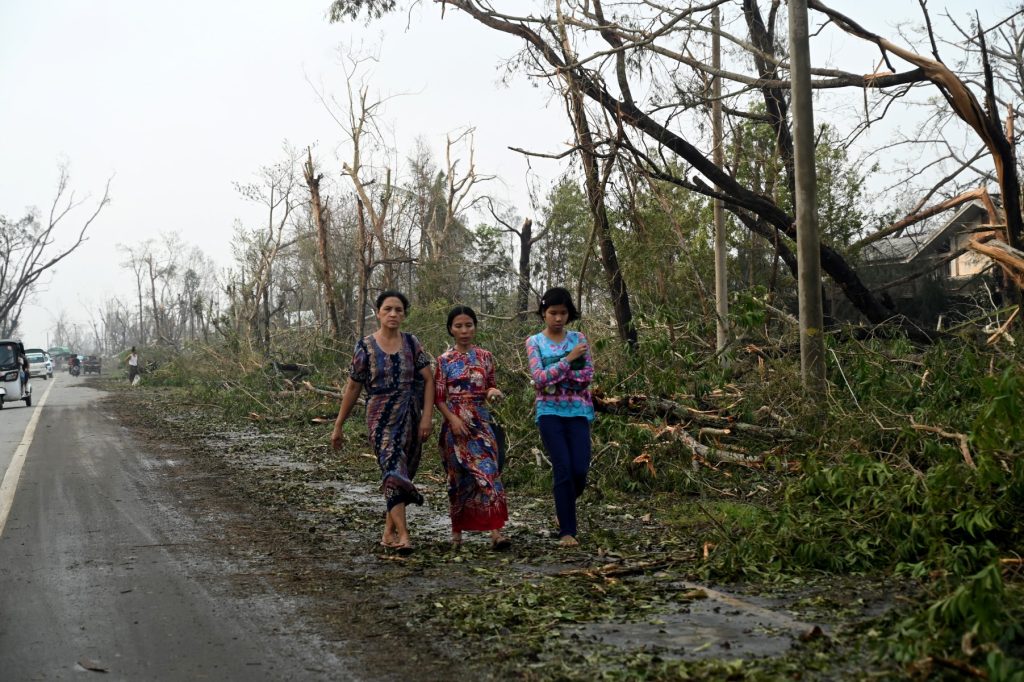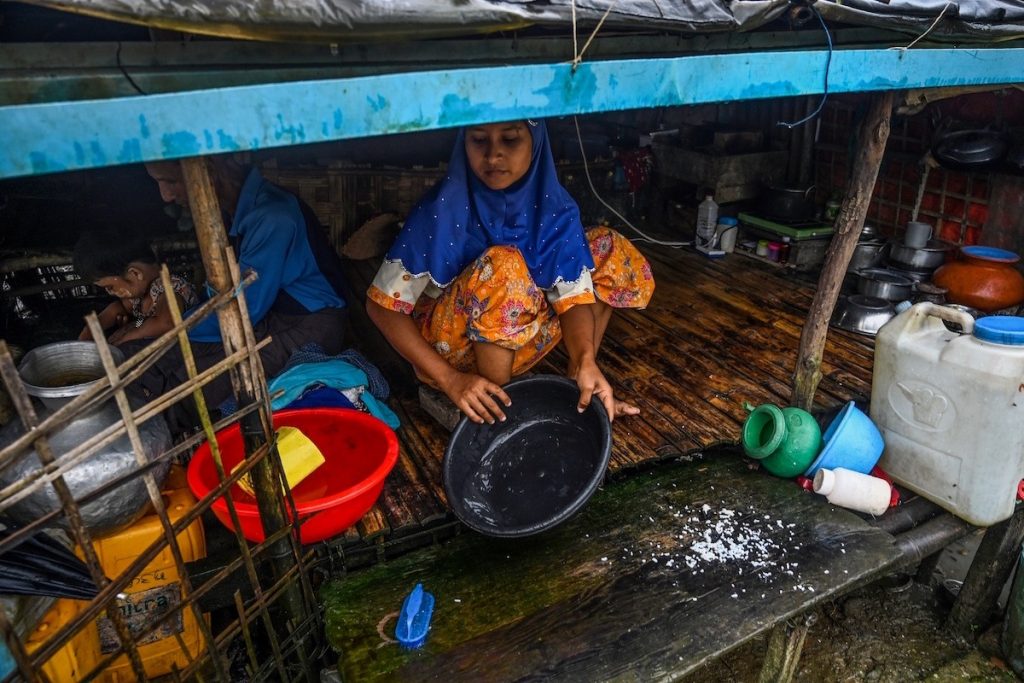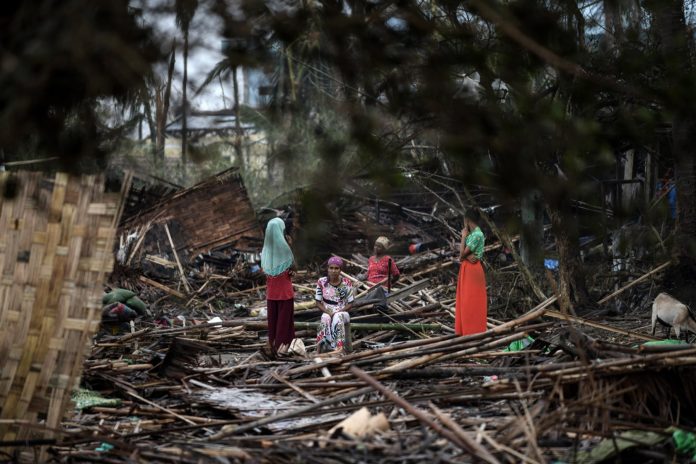Nearly 400 Rohingya living in camps for the displaced in Myanmar’s Rakhine state were probably killed by Cyclone Mocha, the country’s parallel National Unity Government and local aid workers told RFA Tuesday.
The NUG said the figure was based on estimates of the damage, since search and rescue teams have not retrieved the bodies and many victims are still missing. The figure has not been independently verified by RFA.
Volunteers from the Muslim Aid and Relief Society who are collecting field data said most of the dead were children, pregnant women and the elderly. They said they are still searching for bodies.
Aung Kyaw Moe, a Rohingya advisor to the National Unity Government, told RFA Tuesday the majority of the victims were from Sittwe township.
“Some are still missing. This is in Sittwe alone,” he said.
“Bodies were found on the streets and under trees. Search and rescue has not been done yet so we can’t pick up the bodies. All the displacement camps were badly damaged.”
He said that the actual number of casualties could be much higher.
“Some died trying to get up on the roofs of their houses to stay above the flooding, while others were hit by zinc roof sheeting blown by the wind and died,” Aung Kyaw Moe said. “Some pregnant women died with babies in their wombs.”
In many cases, he said, missing Rohingya have yet to be rescued or bodies have yet to be recovered, despite two days having passed since the storm. The dead that have been recovered are being buried immediately, in accordance with Islamic traditions, he added.

‘Camps are open-roof prisons’
There are 21 Rohingya camps in Rakhine state with 120,000 displaced persons staying in 13 camps in Sittwe township.
Nay San Lwin, co-founder of the Free Rohingya Coalition, said the displaced were housed in makeshift tents which were mostly destroyed when the cyclone hit.
“Most of the Rohingya camps did not have time to evacuate [ahead of] the cyclone,” he said.
“Lives are lost when there are no shelters to evacuate the cyclone. The tents were destroyed. The camps are open-roof prisons.”
Nay San Lwin said that the Rohingya “already have targets on their backs” in Myanmar and suggested that authorities may have withheld assistance to their community amid preparations for the storm.
“In the case of such natural disasters, authorities intentionally neglected them, rather than help them survive,” he said. “I don’t think the government of this country had any interest in evacuating them prior to the disaster.”
Residents of Sittwe township said that most of the camps were built close to the sea, leaving them vulnerable to heavy waves, coastal winds and torrential rainfall.
A Rohingya camp resident told RFA that some Rohingya villages “completely disappeared” as the result of flooding.
“I have personally buried more than 10 bodies myself in this camp,” he said, speaking on condition of anonymity. “I also went to other places … [where villages] had been entirely wiped out by the floods, as the sea level rose up to about six meters (20 feet) there.”
Another displaced Rohingya from Sittwe, who also declined to be named for security reasons, said many of the dead bodies he has seen were floating in floodwaters.
“Some people died trying to flee from the danger and their bodies were washed away by the flood,” he said. “Women, children and some men were among them.”
The Rohingya said that roads and bridges leading to the camps have been damaged, hampering transportation in the area.

Difficulties collecting data
Nearly 1 million Rohingya were forced to leave their homes in Rakhine state following a military crackdown against the Muslim-minority in 2017.
About 740,000 fled to Bangladesh and live in Cox’s Bazar, also hit hard by Cyclone Mocha.
Those who remained live in internally displaced persons camps, poorly funded by the junta and volunteer groups.
Collecting information on cyclone victims has been hard because there are only a few volunteers from the Muslim community collecting data in the field, a member of the data collection team told RFA, speaking on condition of anonymity.
It is also hard to collect data on the ground after Sittwe’s largest telecommunications tower collapsed when the cyclone hit it on May 14, cutting phone lines and internet access.
RFA’s calls to the junta spokesman for Rakhine state, Hla Thein, went unanswered Tuesday.
State media reported that junta chief Senior Gen. Min Aung Hlaing personally visited Sittwe on Monday to deliver more than 7 billion kyats (US$ 3.3 million) worth of supplies to those in need.
Cyclone Mocha hit Myanmar’s coast Sunday with sustained winds reaching over 220 kilometers per hour (137 mph).
According to preliminary figures compiled exclusively by RFA, there have been at least 31 deaths due to the cyclone in Rakhine and Chin states, and Ayeyarwady, Magway and Sagaing regions.
Later on Tuesday, the National Unity Government updated its death toll to 435 across the country, with an unspecified number still missing.
The United Nations Office for the Coordination of Humanitarian Affairs said in a flash update on Tuesday that early estimates indicate “nearly 3.2 million are considered to be most vulnerable and are considered likely to have humanitarian needs” across Rakhine state and Myanmar’s northwest in the wake of the cyclone.
Rakhine state and Ayeyarwady region were hit hard by Cyclone Nargis in 2008, leaving nearly 140,000 people dead or missing.









